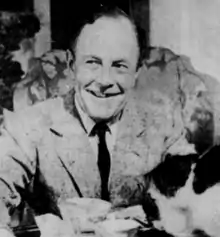Beverley Nichols
John Beverley Nichols (9 September 1898 – 15 September 1983) was an English writer, playwright, composer and public speaker. He wrote more than 60 books and plays.
Beverley Nichols | |
|---|---|
 Photo portrait, 1963 | |
| Born | 9 September 1898 Bower Ashton, Bristol, England |
| Died | 15 September 1983 (aged 85) Kingston upon Thames, England |
| Resting place | Ashes scattered over St Nicholas's Churchyard, Glatton, England[1] |
Career
Between his first book, the novel, Prelude, published in 1920, and his last, a book of poetry, Twilight, published in 1982, Nichols wrote more than 60 books. In addition to fiction, essays, theatre scripts and children's books, he wrote non-fiction works on travel, politics, religion, cats, parapsychology, and autobiography. He contributed to several magazines and newspapers throughout his life, notably weekly columns for the London Sunday Chronicle newspaper (1932–1943) and Woman's Own magazine (1946–1967).[2]
Nichols is best remembered for his books about his homes and gardens, the first of which, Down the Garden Path (1932), was illustrated by Rex Whistler, as were its two sequels. It went through 32 editions and has remained in print almost continuously. The trilogy chronicled the difficulties and delights of maintaining a Tudor thatched cottage in Glatton, Cambridgeshire, the village he fictionalized as Allways. The books are written in a poetic, richly creative style, evoking emotional and sensual responses, leavened with humour and irony.[3] The three books were parodied by W. C. Sellar and R. J. Yeatman in Garden Rubbish (1936), where the Nichols figure was renamed "Knatchbull Twee". Also successful was Green Grows the City (1939), about his urban garden near Hampstead Heath, London. That book introduced Reginald Arthur Gaskin, Nichols's manservant from 1924 until Gaskin's death in 1966. Gaskin was a popular character in the book and was included in Nichols' succeeding gardening books.
A second trilogy (1951–1956) documents Nichols's travails with Merry Hall, a Georgian manor in Agates Lane, Ashtead, Surrey (fictionalized as Meadowstream), where Nichols lived from 1946 to 1956. The books often feature his gifted but laconic gardener "Oldfield". Nichols's final trilogy (1963–1968), concerns his late 18th-century attached cottage (Sudbrook) at Ham, near Richmond, Surrey.
Nichols wrote on a wide range of subjects, always looking for "the next big thing". As examples, he ghostwrote Dame Nellie Melba's 1925 "autobiography" Memories and Melodies (he was at the time her personal secretary, and his 1933 book Evensong was believed to be based on aspects of her life).[4] In 1966 he wrote A Case of Human Bondage about the marriage and divorce of writer William Somerset Maugham and his interior-decorator wife, Syrie, which was highly critical of Maugham. Father Figure (1972), in which Nichols described how he tried to murder his alcoholic, abusive father, caused uproar and calls for his prosecution. He was disappointed by the reception of a book of his about spiritualism.
Nichols was also a competent mystery writer. His five detective novels (1954–1960) featured a middle-aged private detective of independent means called Horatio Green.
Apart from authorship, Nichols's main interest was gardening, especially garden design and winter flowers. His many acquaintances in all walks of life included some famous gardeners like Constance Spry and Lord Aberconway, President of the Royal Horticultural Society and owner of Bodnant Garden in North Wales.
Nichols made one film appearance, in Glamour (1931), directed by Seymour Hicks and Harry Hughes, playing the small part of the Hon. Richard Wells. The film is now lost.
In 1934, Nichols wrote a bestseller advocating pacifism, Cry Havoc![5] By 1938, he had abandoned his pacifism; he supported the British campaign in the Second World War.[5]
Personal life
Nichols was at school at Marlborough College before proceeding to Balliol College, Oxford in January 1917. His education was interrupted by military service with the Intelligence section at the War Office, as an instructor to the Officer Cadet Battalion in Cambridge, and as aide-de-camp to Arthur Shipley on the British University Mission to the United States. Nichols then returned to Oxford, where he was President of the Oxford Union and editor of Isis.[2] He was a homosexual and is thought to have had a brief affair with a famous war poet, Siegfried Sassoon.[6] Nichols's long-term companion was Cyril Butcher, the main beneficiary of Nichols's will, amounting to £131,750.[7]
On 1 August 1944 Beverley Nichols returned from hospital in Peshawar to Hampstead.[8] He died on 15 September 1983 and was buried at Glatton, Cambridgeshire.
Selected bibliography
|
Journalism
Gardening, homes and restoration
Novels
Mysteries
Cats
Religion
|
Spiritualism
Plays
Autobiographies
Political
Biography
Children's Books
Travel
In collaboration
|
References
- "Beverley Nichols the Author at his Thatched Cottage in Glatton". Sawtry Cambridgeshire Community Archive Network. Retrieved 1 May 2019.
- Connon, Bryan (1991). Beverley Nichols: A Life. Constable. ISBN 1604690445.
- Down the Garden Path (1932) ISBN 978-0-88192-710-8
- "The Mercury (Hobart) 5 December 1934". Trove.nla.gov.au. Retrieved 4 December 2013.
- Martin Ceadel, Pacifism in Britain, 1914–1945 : the defining of a faith. Oxford : Clarendon Press, 1980. ISBN 0198218826 (p.239).
- Jean Moorcroft Wilson (2003). Siegfried Sassoon: The Journey from the Trenches: a Biography (1918-1967). Psychology Press. p. 42. ISBN 978-0-415-96713-6.
- "Beverley Nichols' will – Sunday 22 January 1984, p. 5". The Observer: 5. 1984. Retrieved 23 January 2018.
- Box 5, G.B. Stern collection, Howard Gottleib Archive Center, Boston University
External links
- Beverley Nichols papers, held at University of Delaware
- Beverley Nichols: Conserving Moments from His 'Strange and Lovely Life' (online exhibition), at the University of Delaware
- Works by Beverley Nichols at Project Gutenberg
- Works by or about Beverley Nichols at Internet Archive
- Beverley Nichols at Library of Congress Authorities, with 120 catalogue records